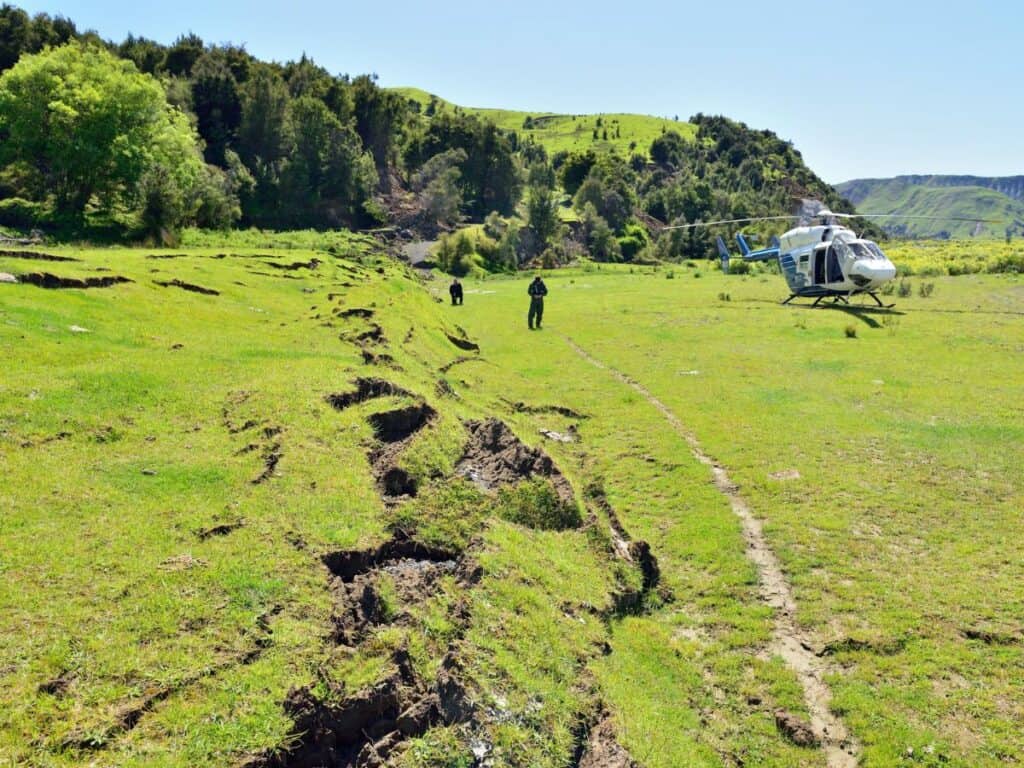Last year Tim Little of Victoria University of Wellington and Russ Van Dissen of GNS Science thought it would be a good idea to find out more about the Kēkerengū Fault in North Canterbury. Through previous work they had identified the Kēkerengū Fault as likely to be the fastest slipping fault within 100 km of Wellington city apart from the Hikurangi subduction zone.
They knew this meant it posed a significant seismic hazard to the northeastern South Island and also to Wellington if linking faults in Cook Strait ruptured at the same time as the Kēkerengū Fault.
In February of this year, with funding from the Natural Hazards Research Platform, Tim and Russ excavated three trenches across the Kēkerengū Fault to look for evidence of past large earthquakes. The main aim of their project was to better constrain the seismic hazard posed by this major active fault.
In these trenches Tim and Russ found evidence that at least three past large earthquakes had occurred in the last 1250 years. These initial results confirmed that the Kēkerengū Fault was capable of producing large earthquakes frequently (on average, about every 300 or 400 hundred years), and was likely to do so again in future.
Then, two weeks ago, as if to say, “Don’t underestimate me!” the fault ruptured right through those same trenches. Tim was awe-struck. As a geologist working on active faults he said, “I had often wondered what it would look like if a fault moved while we were working on a trench cut across it, but I had never expected this to happen to me.”
When the Kēkerengū Fault moved as part of the M7.8 Kaikōura earthquake, the impacts on the landscape were dramatic. One side of the fault has moved as much as twelve metres with respect to the other side. Tim did not expect quite this amount of slip on this fault during a single earthquake. Russ, though, was less surprised – he says it fits with the long-term slip rate calculated for the fault – but he is still amazed to see such fault movement in action.
So, we knew about this fault, we knew it posed a seismic hazard, we even thought it was possible that it would rupture jointly with other faults – New Zealand’s National Seismic Hazard Model specifically includes scenarios that involve joint rupture of the Jordon, Kēkerengū, and Needles Faults. And this, now confirmed by NIWA’s offshore survey of the Needles Fault, is exactly what happened on Monday 14th November. What we had not foreseen is that even more faults would be involved in a single earthquake sequence.
Currently we have evidence for seven faults rupturing in the M7.8 Kaikōura earthquake*, so work on the Kēkerengū Fault is just a small part of the earthquake geology response. There are teams from University of Otago, University of Canterbury, University of Auckland, Victoria University, GNS Science, and NIWA, not to mention volunteers from overseas, currently mapping and measuring the faults that moved last week. We want to understand what happened in this event but, most importantly, what it means for future events.
The Kēkerengū Fault has been speaking to geologists-in-the-making for generations because Victoria University’s third year structural field geology course is held near its northern end. As a student in the early 1990s, I saw the Kēkerengū Fault as a subtle, curious line in the landscape that our professor – Tim Little – stood astride, inciting us to notice. Today, the fault has spoken and it is impossible not to notice.
* Ultimately, over 20 fault ruptures were documented from this earthquake.

